 |
| Director/cinematographer Ed Lachman on Lou Reed and John Cale’s Songs For Drella: “There's an intimacy and remorse in Lou and John enshrouded in their own confessional, isolation and darkness.” |
The great and versatile cinematographer Ed Lachman (who worked with Todd Haynes, Steven Soderbergh, Robert Altman, Paul Schrader, Todd Solondz, Volker Schlöndorff, Sofia Coppola, Werner Herzog, Wim Wenders, Ulrich Seidl, and Jean-Luc Godard) is well represented at the 59th New York Film Festival. Ed’s magnificent Songs For Drella (Lou Reed and John Cale’s tribute to Andy Warhol), Mira Nair’s Mississippi Masala, starring Sarita Choudhury and Denzel Washington (a Revival highlight) and Haynes’ The Velvet Underground (a must see in the Main Slate programme) with on-camera interviews of Lou Reed’s sister Merrill Reed Weiner, Jonathan Richman, Amy Taubin, John Waters, Jackson Browne, Mary Woronov, Gerard Malanga, La Monte Young, Doug Yule, Danny Fields, Sterling’s wife Martha Morrison, Maureen Tucker and Cale, shot by Lachman, are all screening in the festival.
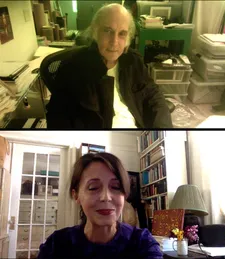 |
| Ed Lachman with Anne-Katrin Titze on Todd Haynes: “He always does incredible research for his ideas.” |
Drella, the name, combines Warhol’s qualities of Dracula and Cinderella: a charming, blood-sucking impostor who dazzles everyone at the ball, hard-working, the perfect host, living on forever. When Cale and Reed met again, at the memorial service for Warhol at St. Patrick’s Cathedral, years after the bad breakup of The Velvet Underground, the idea for the program was born. This is musical storytelling at its best, with every song elucidating not only the experiences of Drella and the two composers/performers, but questions that concern us all. Faces and names? If they all were the same, I would be you and you would be me.
From New York City, Ed Lachman joined me for an in-depth conversation on the history of Songs For Drella and more.
Anne-Katrin Titze: Hello Ed!
Ed Lachman: Hello! That’s so nice that you want to do this!
AKT: How did it all start with Songs For Drella?
EL: This all came about 32 years ago. I had done something for Annie Lennox, who was doing with Derek Jarman Red, Hot + Blue. It was an AIDS benefit and they did videos of Cole Porter songs.
AKT: Yes, I actually vaguely remember that.
EL: But Derek was too sick at the time we were going to shoot, so he gave me his videos of his childhood growing up, his Super 8, and I projected them on Annie Lennox’s face as she sang Ev'ry Time We Say Goodbye. That got a lot of recognition in London. Because of that I was offered to shoot and direct Songs For Drella. It was originally for Channel 4 through Initial Films.
 |
| Ed Lachman on John Cale and Lou Reed’s Songs For Drella: “Images is a great one. Forever Changed is lovely. The songs have really grown with me ” |
And over the years I’ve often thought about it. They only came out with a laser disk that wasn’t very good. I didn’t have any control over the timing, the colour, and it was all lost. I couldn’t find it. Warner Bros. didn’t know where it was, because they had done the album. Channel 4 didn’t know where it was. But during the pandemic, I had asked DuArt, the lab in New York that was closing, to send anything with my name on it to me at my loft. In the interim, I had started this film with Todd Haynes, The Velvet Underground, and I told him about it. The producer Carolyn Hepburn said, look, I’ll help you find it, maybe we could use a clip or parts of it. They made the decision that they only wanted to use the years from ’63 to ’73.
AKT: Yes, I noticed that there was nothing from before or after.
EL: So she helped me; we talked to Channel 4, we talked to Initial. Meanwhile the company had been sold a couple of times. I was at a loss that I would never find it. And going through my boxes - you can see my loft here - I found the A and B rolls, the original camera negative of Songs for Drella. So if no one is going to do anything with it, I’m going to do something with it. Then I had to find the sound. I have the sound from a laser disk and an optical track, I didn’t have the real original tracks. Well, Warner Bros. finally, finally found the tracks for the album, which would be the best sound ever! It wouldn’t sync up to the film, because it was in a different order, the songs.
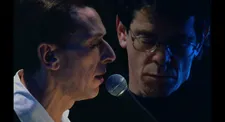 |
| John Cale and Lou Reed performing Smalltown in Songs For Drella |
I found somebody also who could do sound restoration and told me it’s only Xs and Os, I can sync it up! And he did. I have the best picture and the best sound that I possibly could have and it’s from the original negative and now it can be projected in a theater and experienced. The original concept of this, when I talked to Lou and John about doing this, the first thing that Lou said was “I don’t want the camera between me and the audience.” I thought about it and I said “Can I shoot the rehearsals?” And that gave me the greatest freedom.
AKT: Of course!
EL: Then I could set up the cameras; I used a dolly and primarily did the rehearsals myself.
AKT: So there was never anybody in the audience when you were shooting them?
EL: No. And so I made a decision the one night I shot the performance, I wouldn’t shoot anybody in the audience. I would make it a very personal experience so the audience would always be the people that sit in the theater to see this. The set and the stage lent itself that way because it was in black, it was a total void except for these projections.
AKT: Did you change anything about the projections for your film?
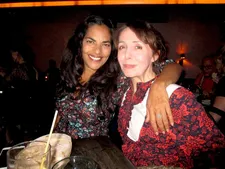 |
| Mira Nair’s Mississippi Masala star Sarita Choudhury with Anne-Katrin Titze Photo: Anne-Katrin Titze |
EL: What I could do in a DI digitally, I couldn’t do back then. Now I spent like a week and go into every song and find its own visual grammar and colour and texture.
AKT: I love the bright red background for the song Work, for example.
EL: It was there, but not like it is in the film, because I could enhance it digitally. I could enhance the shadows, the colour.
AKT: There are some wonderful visual details that I picked up that connect to Drella, the Dracula part of the name. First of all, the big white pointed collar that John Cale wears.
EL: Yeah, I never thought of that.
AKT: And there are Lou’s guitar picks on the microphone stand which look like two little teeth.
EL: Oh my god, I didn’t notice.
AKT: Just little details to remind us of the vampiric quality.
EL: I just showed it at Telluride and it was a surprise. A documentary couldn’t say more, their reactions to each other, because it’s just the two of them and so there is this interplay between them. For me, it’s a tribute, an homage, a eulogy, a dirge, a memorial and a confession, a reflection. For me it’s a poem in verse and music that traces Andy Warhol's life, dreams, aspirations, work, and personal thoughts in his fears and disappointments.
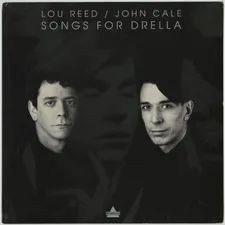 |
| Lou Reed / John Cale - Songs For Drella |
There's an intimacy and remorse in Lou and John enshrouded in their own confessional, isolation and darkness. Without a feeling of an audience or seeing one, you are the only audience present, singing to themselves and each other as we observe them, like opening someone's diary. For me there’s a narrative in the text from when Andy first comes to New York to the end with his fear of having any social interactions with people.
AKT: Apropos, did you have any interactions with Andy Warhol?
EL: I actually did meet him. I live on 19th Street, I didn’t then. But I’d been to the studio. Yeah, I’m old enough to have been around and I knew Nico. That was another strange thing about shooting The Velvet Underground, because I knew a lot of the people that we were shooting.
AKT: I like very much the personal perspective in Drella.
EL: The camera is a participant observer like the taciturn Warhol. You know, people always made a point about Andy being a voyeur or some sort of Svengali character but for me he was always more a passive observer and he was someone who lived through others. Someone at Telluride said that you felt the presence of Warhol observing them.
AKT: It’s as much about him as it is about them. When you were filming John Cale now for The Velvet Underground, so many years after Drella, did you talk with him about it?
 |
| Gerard Malanga, Andy Warhol, Lou Reed, and Maureen Tucker in Todd Haynes’ The Velvet Underground, shot by Ed Lachman |
EL: No, we were very cordial with each other and I’m going to see him at the festival.
AKT: One of the moments I found amazing in what you shot for The Velvet Underground was The Ostrich dance performed by Lou Reed’s sister. You shot that, right?
EL: Yeah, that was just out of the blue, you know.
AKT: Do you have a favorite one among the songs for Drella?
EL: Images is a great one. Forever Changed is lovely. The songs have really grown with me. They take on a different kind of importance. Somebody told me Lou Reed’s birthday is coming up?
AKT: March 2 next year will be his 80th birthday. The Performing Arts Library is going to have a big exhibition. I had a conversation with Timothy Greenfield Sanders, who did a very good Lou Reed documentary in the late Nineties, called Lou Reed: Rock And Roll Heart. He used some footage of Drella as well.
EL: I made a poster yesterday, maybe you could post that!
 |
| Songs For Drella poster |
AKT: A few things about The Velvet Underground and the interviews you shot. I loved the one with Amy Taubin and what she says about women at the Factory.
EL: Sure, I have known her for years. I never saw her back then, I was wow! She’s still attractive and beautiful but she was stunning when she was young.
AKT: You shot her very beautifully, too.
EL: Oh, thank you.
AKT: When you discussed with Todd how you were going to shoot the people, did the Warhol Screen Tests come up?
EL: Yes, yes, I would say the reference was somewhere between the Screen Tests and, you know, the coloured backgrounds were like the photographic silk screens of Warhol. You know, the Marilyn and all the stars and non-stars that he did those lithography images. So I tried to capture the colour, the flat primary colours from that and the lighting was always one source the way they lit. They would just use a spotlight and shoot with their Bolex. It was a combination of the photographic coloured silk screens and the lighting of the Screen Tests.
AKT: You have made so many films together with Todd Haynes by now. Do you have shortcuts? Also is it very different from planning a fictional film, such as Carol?
EL: He always does incredible research for his ideas. So we certainly delved into the idea of around the Sixties, the experimentation in filmmaking and the art movements. But I just shot the interviews, my canvas wasn’t as big. Every film is a different journey with Todd because he’s always exploring not only the language of the time, but also the approach to the filmmaking. Let’s say, like The French Connection, they were using what was called a western dolly in the street with rubber wheels to go across the streets for those long tracking shots.
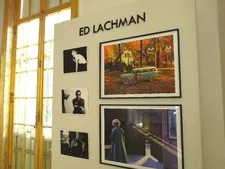 |
| Ed Lachman photographs I'm Not There - Far From Heaven at Anne-Dominique Toussaint’s Parisian Galerie Cinéma in New York Photo: Anne-Katrin Titze |
Now today we would do that on a crane or on a dolly. When you have traffic you can’t have the track on the street, so Todd said, why don’t we do it the way they did The French Connection? So, wow, to tell the crew I want to do it the way they did it 30 or 40 years ago was: why are we doing it that way when there’s a better way to do it? No, Todd wants to do it the way they did it. And it gives a different feeling to the images.
AKT: One of your specialties is that you frequently shoot films with very unappetizing subject matter. I am thinking of Ulrich Seidl or Todd Solondz - they have such horrific subject matter at times and you provide fantastic images to go with them. The juxtapositions are great and they are both great filmmakers.
EL: I love both of them. I think they have great empathy for their characters but that’s kind of what their stories are really about. They want you to look at people that you don’t normally see, to have a compassion of who they are. I met Ulrich through Werner Herzog many years ago. He had seen a film I had co-directed with Larry Clark, Ken Park, and he said “Oh, that’s kids’ stuff, you have to meet Ulrich Seidl.” And I was going that year to Vienna to the Viennale and we became friends and I think he’s really one of the great European directors.
AKT: I agree. And he is tackling topics that others would shy away from. Are there any films in the New York Film Festival that you are particularly looking forward to seeing?
 |
| Lou Reed: Caught Between the Twisted Stars opens on March 2, 2022 at The New York Public Library for the Performing Arts at Lincoln Center Photo: Anne-Katrin Titze |
EL: Obviously the one that won at Cannes [Titane]. And I have two other films in the festival, The Velvet Underground and a restoration of Mississippi Masala. Also I am friends with and haven’t seen Michelangelo Frammartino’s new film.
AKT: I am very much looking forward to that as well. I loved Alberi most.
EL: He’s a great filmmaker.
AKT: Thank you so much. Ciao!
EL: Alright, bis später! Ciao!
Post-screening Q&A with Todd Haynes, Christine Vachon, Julie Goldman, Chris Clements, Rob Komadina, David Blackman, and John Cale on September 30, 6:00pm at Alice Tully Hall.
The October 2, 7:00pm outdoor screening at Damrosch Park will be preceded by Songs for Drella and followed by a Q&A with Haynes and Ed Lachman.
Final screening of Mississippi Masala is at 3:30pm today inside the Francesca Beale Theater at Lincoln Center. On September 25, Mira Nair, Sarita Choudhury and Edward Lachman participated in an in-cinema post-screening discussion.
On March 2, 2022, Lou Reed's 80th birthday, The New York Public Library for the Performing Arts at Lincoln Center will open the exhibition Lou Reed: Caught Between the Twisted Stars. It will be on view through August 27, 2022 and will include photographs by Timothy Greenfield-Sanders.





















